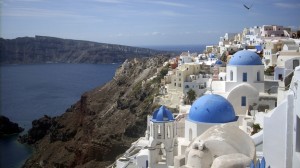Santorini is known as a prized gem of the Grecian islands, a tiny alcove surrounded by water and loved by residents and tourists alike. The multicolored limestone houses are built onto a cliff overlooking the sea with spectacular views of the sunset; Santorini retains the Cycladic architecture of its past.

Unfortunately this is where the article’s positivity ceases; if you are now thinking of visiting Santorini, the sooner the better, because it has been recently prone to bubbles of volcanic explosion underneath its earth.
Santorini was built out of a volcanic eruption about 3,600 years ago, in approximately 1620 BC, obliterating the ancient Minoan civilization that once called this island home. (This is also how the legends of the “Lost City of Atlantis” arose). Santorini is known for its volcanic explosions, which happen about every 20,000 years.
The volcano under Santorini has been relatively silent in the past 25 years, but now it is seemingly becoming more active. In the past year, the amount of magma underneath the island has been at a steady increase, and is now said to be the size of 15 Olympic stadiums.
Because of this large growth spurt, the island has recently risen up 5.5 inches. Tourists have been feeling small rumbles on the surface, and an occasional clinking of their wine glasses as the volcano pulsed beneath them.
Earlier this year, seismic GPS sensors measured activity, hinting that there may be an eruption soon. Although they do not think an eruption the size of the one 3,600 years earlier will be in store for the island, researchers have been actively keeping an eye on the volcano.
Volcanologist David Pyle is not worried though, saying that this is typical of such a volcano.
“They’ll often have these little restless patches, because there is molten rock moving around at depth,” he says, assured that this kind of situation is fairly commonplace.
Nevertheless, if you have ever desired to visit Santorini, now is your time to do so, as its future is fairly unpredictable. Just as one is never sure how much air a balloon will take before it pops, the volcano can only handle a certain amount of pressure before it bursts upwards.







